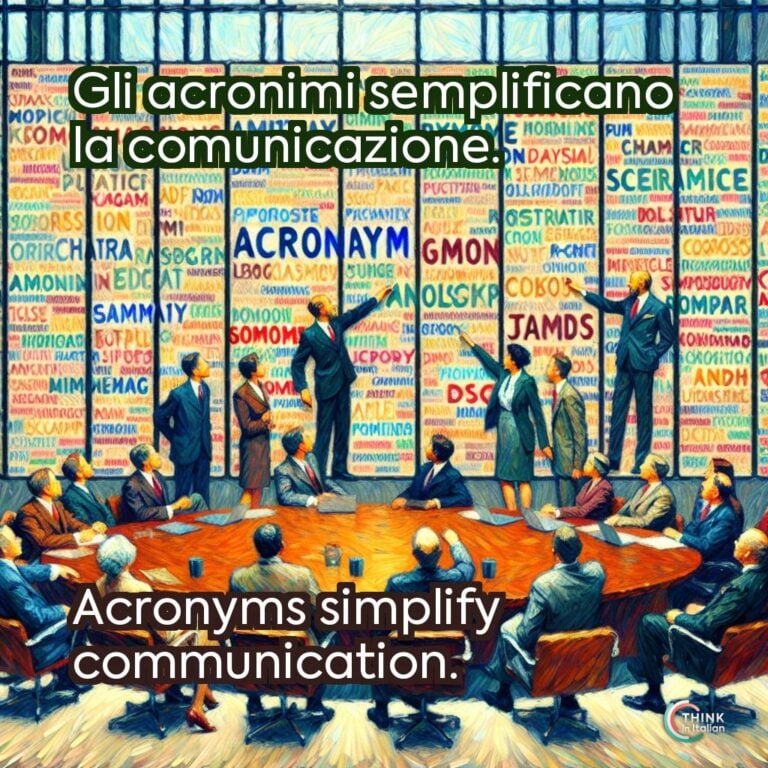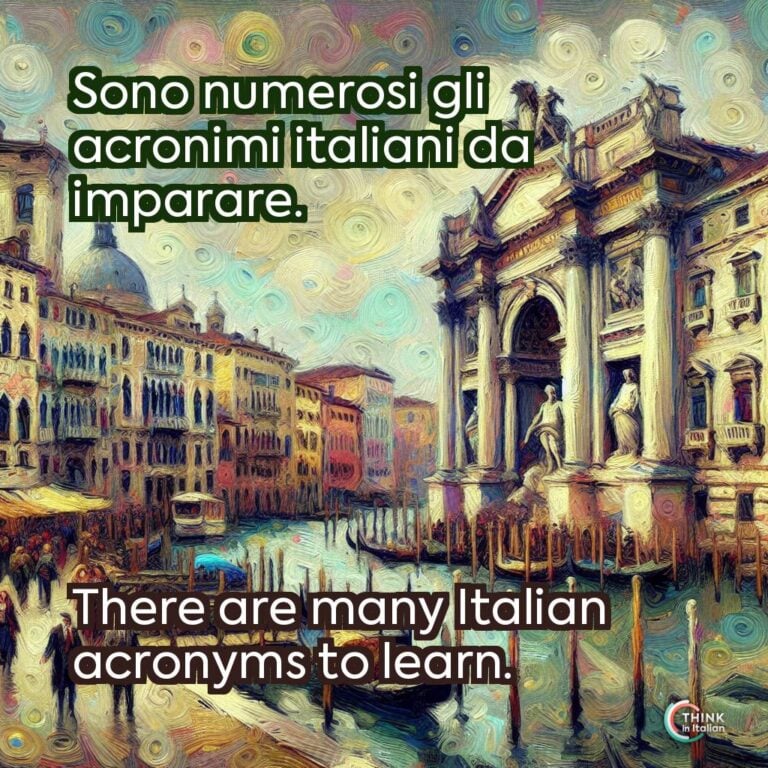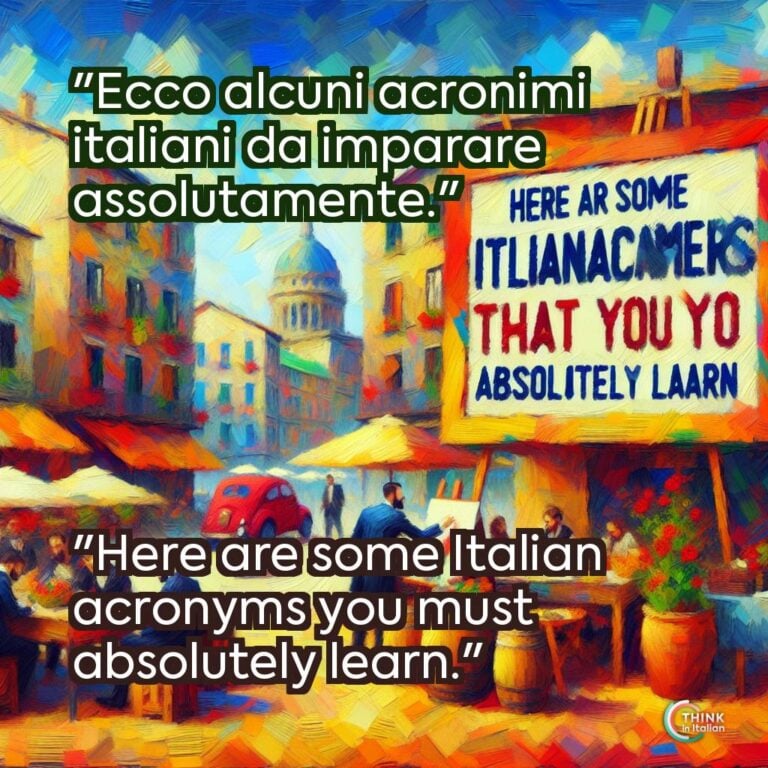What are Acronyms and Abbreviations?
Acronyms and abbreviations are shortened forms of phrases or words, often composed of the initial letters or syllables of their components. They are common in languages worldwide as they make communication quicker and easier. Specifically:
- Acronimi (acronyms) are formed by taking the first letters of a phrase and combining them to create a new, pronounceable word. For example, FIAT is an acronym for Fabbrica Italiana Automobili Torino, and it is pronounced as a single word.
- Abbreviazioni (abbreviations) are shortened forms of words or phrases, often made by omitting letters and adding a period at the end, like Prof. for Professore (Professor). They don’t necessarily form a new word and may not be pronounced as a single term.
In Italian, some acronyms are pronounced as standalone words, while others are pronounced letter by letter, depending on their structure and length.
Below, I will provide you with a list of the most common Italian acronyms and abbreviations, as well as some examples to learn the contexts in which you might find them.
Italian Acronyms and Abbreviations
Italian Acronyms
Italian acronyms are found in nearly every domain, from politics and media to healthcare and finance. Here are some examples and their meanings:
- ANAS – Azienda Nazionale Autonoma delle Strade (National Road Agency)
- ASL – Azienda Sanitaria Locale (Local Health Agency)
- BCE – Banca Centrale Europea (European Central Bank)
- CAP – Codice di Avviamento Postale (Postal Code)
- CNR – Consiglio Nazionale delle Ricerche (National Research Council)
- DPCM – Decreto del Presidente del Consiglio dei Ministri (Prime Minister’s Decree)
- FIAT – Fabbrica Italiana Automobili Torino (Italian Car Factory)
- INPS – Istituto Nazionale della Previdenza Sociale (National Social Security Institute)
- IRCCS – Istituto di Ricovero e Cura a Carattere Scientifico (Scientific Research Hospital)
- ISS – Istituto Superiore di Sanità (Higher Institute of Health)
- IVA – Imposta sul Valore Aggiunto (Value-Added Tax)
- N.B. – Nota Bene (Note Well)
- OMS – Organizzazione Mondiale della Sanità (World Health Organization)
- ONLUS – Organizzazione Non Lucrativa di Utilità Sociale (Nonprofit Organization)
- PD – Partito Democratico (Democratic Party)
- PIL – Prodotto Interno Lordo (Gross Domestic Product)
- PNRR – Piano Nazionale di Ripresa e Resilienza (National Recovery and Resilience Plan)
- PS – Pubblica Sicurezza (Public Safety Department)
- P.S. – Post Scriptum (Postscript)
- Q.B. – Quanto Basta (As much as needed; in recipes)
- RAI – Radiotelevisione Italiana (Italian Broadcasting Corporation)
- S.P.A. – Società per Azioni (Corporation)
- S.R.L. – Società a Responsabilità Limitata (Limited Liability Company)
- SGR – Società di Gestione del Risparmio (Investment Management Company)
- SPID – Sistema Pubblico di Identità Digitale (Public Digital Identity System)
- TG – Telegiornale (News Program), e.g., TG1, TG2, TG3
- UPIM – Unico Prezzo Italiano di Milano (Popular Italian Department Store)
Italian acronyms follow specific pronunciation rules depending on their length and format. In order to be able to properly pronounce them, I suggest you have a look at the Italian alphabet to know the basic pronunciation rules.
Acronyms with three or more letters are generally pronounced as a single word, like FIAT or RAI, especially when vowels and consonants are well alternated.
Two-letter acronyms, like PS and PD, are pronounced letter-by-letter, also if they are composed of a consonant and a vowel. The same applies to those involving periods, like N.B. and Q.B., those with a mix of upper and lowercase letters, like S.p.A..
Italian Abbreviations
Italian abbreviations are commonly used for professions, social settings, and practical information. They often appear in formal and professional contexts or on official documents.
- A.C. – Anno Corrente (Current Year) but also Avanti Cristo (Before Christ)
- Avv. – Avvocato/a (Attorney, male or female)
- C.F. – Codice Fiscale (Italian Tax Code)
- D.C. – Dopo Cristo (After Christ – Anno Domini)
- Dott. – Dottor (Doctor or physician, male)
- Dott.ssa – Dottoressa (Doctor or physician, female)
- Egr. – Egregio (Distinguished, male. Used in very formal communications)
- Egr.ia – Egregia (Distinguished, female)
- Gent.ma – Gentilissima (Dear, female)
- Gent.me – Gentilissime (Dear, female plural)
- Gent.mi – Gentilissimi (Dear, male plural)
- Gent.mo – Gentilissimo (Dear, male. Used in formal writing)
- Ill.ma – Illustrissima (Distinguished, female)
- Ill.mo – Illustrissimo (Distinguished, male. Used for important persons in science or literature)
- Ing. – Ingegnere/a (Engineer, male or female)
- Prof. – Professor (Professor, male)
- Prof.ssa – Professoressa (Professor, female)
- Sig. – Signor (Mr)
- Sig.ra – Signora (Mrs or Ms)
- Spett.le – Spettabile (Dear, for companies and organizations)
- dx – destra (right)
- sx – sinistra (left)
How to Use Italian Acronyms and Abbreviations in Daily Life
In Italian daily life, acronyms and abbreviations serve as both convenient and culturally embedded tools. Italians use them to simplify complex terminology, enhance brevity in written communication, and create a shared understanding in various contexts.
When communicating in a professional or formal setting, abbreviations are preferred to show respect and maintain conciseness, as with titles such as Dott. or Ing..
They are both equally present in informal settings, particularly in spoken Italian and digital communication, as well as local authorities or consulting timetables.
Incorporating these abbreviations and acronyms into your vocabulary will give you an insider’s perspective on Italian culture, bureaucracy, and communication style, helping you understand the Italian “alphabet soup” with confidence.






